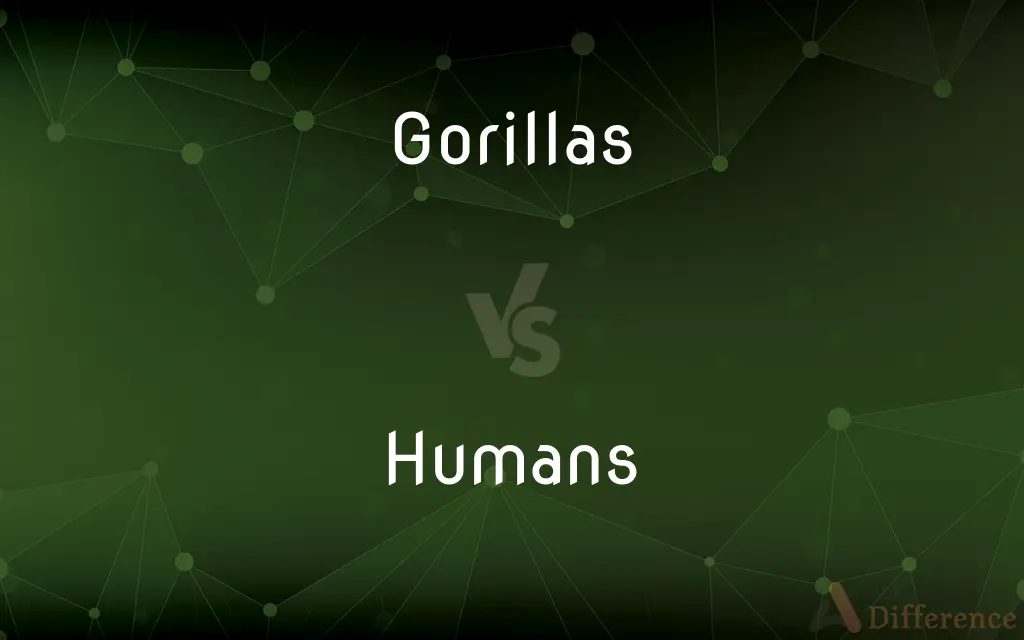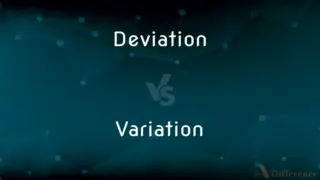Gorillas vs. Humans — What's the Difference?
By Tayyaba Rehman — Updated on September 27, 2023
Gorillas are large, primarily herbivorous apes inhabiting African forests, exhibiting complex social structures and behaviors. Humans are highly intelligent, bipedal beings capable of abstract thinking, language, and creating complex societies.

Difference Between Gorillas and Humans
Table of Contents
ADVERTISEMENT
Key Differences
Gorillas and Humans both belong to the Hominidae family but diverge significantly in terms of intelligence, physical attributes, and societal development. Gorillas, primarily residing in the dense forests of central Sub-Saharan Africa, exhibit remarkable strength and predominantly consume a herbivorous diet. Humans, on the other hand, are omnipresent, showcasing unparalleled intellectual capacities, allowing the construction of intricate societies, technological advancements, and the ability to manipulate their environment extensively.
Gorillas live in cohesive groups, exhibiting complex social structures with defined roles, led by a dominant male, called the silverback. Humans have developed highly complex societal structures, with diverse cultures, languages, and governmental systems, emphasizing cooperation, law, and order.
Gorillas, being non-verbal, communicate through vocalizations, gestures, and body postures, expressing emotions and intentions. Humans possess advanced communicative abilities, utilizing complex languages, enabling them to convey abstract thoughts, emotions, and information, serving as a foundation for cultural and societal evolution.
Gorillas have a remarkable adaptation to their environment, characterized by robust bodies and long arms facilitating quadrupedal locomotion. Humans exhibit erect bipedalism, freeing their hands for tool use and manipulation of the environment, leading to unprecedented technological and societal progression.
Gorillas play a pivotal role in maintaining ecological balance in their habitats, aiding in seed dispersal and regulating vegetation growth. Humans, due to their intellectual and technological advancements, impact the environment on a global scale, altering ecosystems and climate, with the capability for both conservation and destruction.
ADVERTISEMENT
Comparison Chart
Physical Attributes
Large bodies, long arms, predominantly quadrupedal.
Erect, bipedal posture, capable of fine motor skills.
Dietary Preferences
Primarily herbivorous.
Omnivorous, with diverse dietary preferences.
Habitat
Central Sub-Saharan Africa, forested regions.
Global, adaptable to varied environments.
Social Structure
Live in groups, led by a dominant male (silverback).
Complex societies with diverse cultural structures.
Communicative Abilities
Use vocalizations, gestures, and postures.
Utilize complex languages to express abstract thoughts.
Compare with Definitions
Gorillas
Large, predominantly herbivorous apes native to the forests of central Africa.
Gorillas, residing in the dense forests, play a crucial role in maintaining the ecological balance of their habitats.
Humans
Possess the ability to think abstractly, create, and manipulate their environment.
Humans have shaped and altered their surroundings, developing tools, technologies, and constructs.
Gorillas
Exist in cohesive groups led by a dominant male, called the silverback.
In gorilla groups, the silverback makes pivotal decisions and maintains order and cohesion within the troop.
Humans
Highly intelligent, bipedal beings with advanced communicative abilities and complex societal structures.
Humans, with their intellectual prowess, have built civilizations and made significant technological advancements.
Gorillas
Communicate through a range of vocalizations, gestures, and postures.
Gorillas communicate their emotions and intentions effectively through diverse vocalizations and body movements.
Humans
Diverse in culture, language, and societal norms, forming intricate societies.
The diverse cultures and societies developed by humans reflect their adaptability and complexity.
Gorillas
Primarily quadrupedal, with bodies adapted to their environment.
Gorillas, with their robust bodies and long arms, navigate their environments efficiently.
Humans
Spread globally, capable of adapting to varied environmental conditions.
Humans inhabit diverse environments, from arid deserts to frozen tundras, showcasing their adaptability.
Gorillas
Known for their remarkable strength and complex social structures.
Gorillas, with their immense strength and structured social hierarchy, exhibit fascinating behavioral patterns.
Humans
Exhibit a broad range of emotions, moral values, and ethical principles.
The moral and ethical compass of humans guides their actions and decisions, influencing societal norms and values.
Gorillas
Either of two large apes (Gorilla gorilla or G. beringei) native to the forests of equatorial Africa, having a stocky body and coarse dark brown or black hair.
Humans
A member of the primate genus Homo, especially a member of the species Homo sapiens, distinguished from other apes by a large brain and the capacity for speech.
Gorillas
A powerfully built, aggressive, and often crude man.
Humans
A person
The extraordinary humans who explored Antarctica.
Gorillas
A thug.
Humans
Of, relating to, or characteristic of humans
The course of human events.
The human race.
Gorillas
Plural of gorilla
Humans
Having or showing those positive aspects of nature and character regarded as distinguishing humans from other animals
An act of human kindness.
Humans
Subject to or indicative of the weaknesses, imperfections, and fragility associated with humans
A mistake that shows he's only human.
Human frailty.
Humans
Having the form of a human.
Humans
Made up of humans
Formed a human bridge across the ice.
Humans
Plural of human
Humans
All of the inhabitants of the earth;
All the world loves a lover
She always used `humankind' because `mankind' seemed to slight the women
Common Curiosities
Are gorillas the closest relatives to humans?
No, chimpanzees and bonobos are closer relatives to humans than gorillas.
Are gorillas endangered?
Yes, some gorilla species are critically endangered due to habitat loss and poaching.
Can humans communicate with gorillas?
Partially, using sign language, some gorillas have been taught to communicate with humans.
Do gorillas use tools?
Yes, gorillas have been observed using tools in the wild to aid in feeding and other activities.
How strong are gorillas compared to humans?
Gorillas are estimated to be around four to nine times stronger than an average human.
Can gorillas experience emotions?
Yes, gorillas exhibit a range of emotions similar to those experienced by humans.
Do gorillas have unique fingerprints like humans?
Yes, gorillas, like humans, have unique fingerprint patterns.
Are humans the only beings capable of abstract thought?
Current understanding suggests that humans uniquely possess advanced abstract thinking abilities.
Can humans and gorillas interbreed?
No, humans and gorillas cannot interbreed due to significant genetic differences.
Are humans the only species with a sense of morality?
It’s debated, but humans exhibit a complex and unique moral and ethical understanding.
Why are humans so diverse genetically?
Genetic diversity in humans is due to mutations, genetic recombination, and evolutionary pressures.
How are humans impacting gorilla populations?
Habitat destruction, climate change, and poaching by humans are severely impacting gorilla populations.
Can humans adapt to any environment?
Humans have a high adaptability but extreme conditions can limit human habitation without technological aid.
How intelligent are gorillas?
Gorillas are highly intelligent, capable of learning, problem-solving, and exhibiting emotional depth.
Can gorillas and humans share diseases?
Yes, gorillas and humans share a vulnerability to several diseases, including Ebola and respiratory infections.
Share Your Discovery

Previous Comparison
Cleaner vs. Cleanser
Next Comparison
Deviation vs. VariationAuthor Spotlight
Written by
Tayyaba RehmanTayyaba Rehman is a distinguished writer, currently serving as a primary contributor to askdifference.com. As a researcher in semantics and etymology, Tayyaba's passion for the complexity of languages and their distinctions has found a perfect home on the platform. Tayyaba delves into the intricacies of language, distinguishing between commonly confused words and phrases, thereby providing clarity for readers worldwide.













































